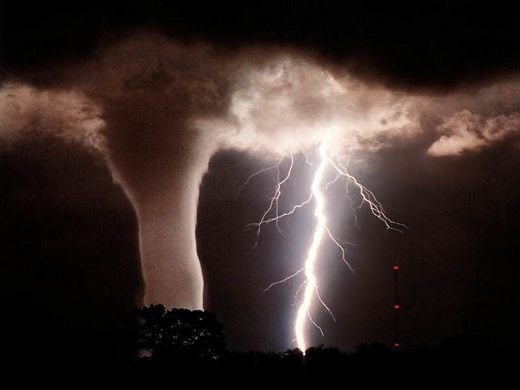Rising moist air mixed in with colder dry air at higher altitudes helped create the perfect conditions for a flurry of tornadoes that swept across the Midwest states of Oklahoma, Kansas, Nebraska, and Iowa, last weekend.
While initial reports estimated over 120 twisters, Greg Carbin, the warning coordination meteorologist for the National Storm Prediction Center in Norman, Oklahoma believes that many of them were reported twice and put the number closer to 75.
Fortunately, most of the tornadoes were short-lived or went past primarily rural areas. However, there were a few that were not as considerate. The hardest hit was Woodward a small city of 12,000 residents in Oklahoma, Not only did the twister cause extensive property damage but also, took the lives of six residents, including three children and injured over 24. The reason for these deaths and injuries, the only ones reported, is being attributed to the lack of warning, because the town's alarm malfunctioned after being hit by lightning.
The storms also razed between 75- 90% of the homes and buildings in the small city of Thurman, Iowa, home to 250 residents. While Wichita in Kansas did suffer some damage, it was not extensive thanks to the fact that the twister skirted around the most populated areas.

Though US tornado season begins in earnest from March and continues until June, the storms have increasingly been starting earlier and earlier. In 2011, the worst year on record for twisters, the first tornado hit on New Year's day and then to continued well into June. 550 people lost their lives while another 5.400 were injured. The storms destroyed property worth $10 billion USD the most ever, in US history. The year will also go down in the record books for the most tornadoes in a single day (211) and, a single month (758).
With over 95 tornadoes reported in January alone, the 2012 season also seems to be equally severe and with the worst months yet to come; we can only hope for the best. Unfortunately, there is no way to forecast how bad the tornado season will be. That's because unlike blizzards and hurricanes, which take the time to develop and spend hours lumbering across, tornadoes are small and quick, making predictions so difficult, that even a 20-minute warning is considered safe.
What Are Tornadoes and How They Form

A tornado is a very powerful rotating column of air that starts from the bottom of a thunderstorm cloud and extends all the way down to the ground. They form only during very severe rotating storms, called supercells that occur when cold dry polar air comes in contact with warm moist tropical air.
As the hot air rises, winds around the storm cause it to rotate and form a funnel. The air in the funnel spins faster and faster, creating a low-pressure area, which sucks in even more air and sometimes, even objects. While ordinary thunderstorms last between 30-60 minutes, supercells develop many updrafts and downdrafts and can live on for hours.

While tornadoes occur all over the world, the US gets the most - About 1,200 a year. The worst hit area is a stretch of land known as Tornado Alley that extends from Texas to South Dakota. Here, the dry air from the Rocky Mountains meets warm, moist air from the Gulf and cold Arctic air from the north - Perfect conditions for storms that are powerful enough to turn into tornadoes.
Resources: bostonglobe.com,huffingtonpost.com, reuters.com, noaa.gov